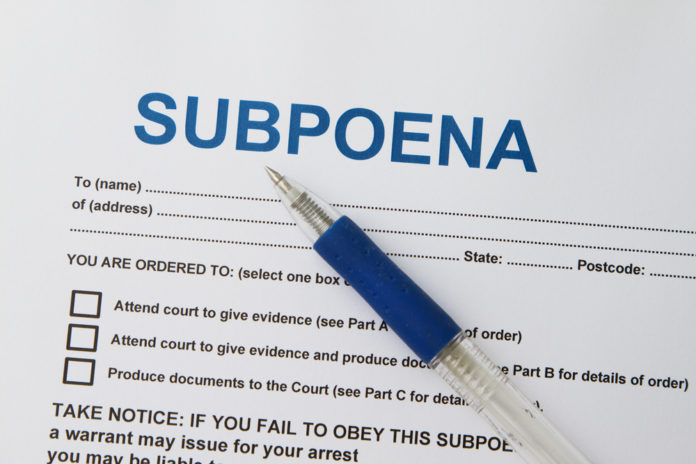Surety’s motion to quash a government subpoena is granted. As part of an appeal before the ASBCA, the government subpoenaed a surety seeking information related to a Miller Act claim filed by a subcontractor against the contractor’s surety. The surety moved to quash the subpoena alleging undue burden. The board agreed with the surety. First, the subpoena did not seek relevant information. It was unclear how information from the Miller Act claim would help resolve the CDA appeal. Second, the subpoena requested duplicative information. The information the surety possessed had come from the contractor. The government could have obtained that same information through direct discovery from the contractor itself.
Sand Point Services, LLC had a contract with NASA to repair an aircraft parking apron. The contract required Sand Point to obtain a bond. Sand Point obtained a bond from Fidelity and Deposit Company (F&D).
One of Sand Point’s subcontractors submitted a claim to F&D on the bond. F&D denied the claim. The subcontractor filed suit against F&D in district court under the Miller Act. Sand Point intervened, arguing the suit was premature because the subcontractor had not completed work on the project. The parties ultimately settled the Miller Act suit.
A year after the Miller Act case settled, Sand Point filed appeals with the ASBCA challenging the denial of claims asserting constructive change and differing site conditions. NASA moved to dismiss the appeals arguing that the contracting officer’s final decision was based on suspicion of fraud. Specifically, NASA argued that Sand Point had admissions in the Miller Act case that contradicted the allegations it was making in the appeals before the board. The board denied NASA’s motion, reasoning that it could resolve the appeals without making factual determinations of fraud.
Thereafter, NASA served a subpoena duces tecum on F&D, seeking information related to the subcontractor claim and the Miller Act case. NASA also obtained, but did not serve, a subpoena to F&D’s counsel, which sought similar information. F&D moved to quash the subpoena it been served with. Sand Point also moved to quash the subpoena issued to F&D and the surety’s attorney.
The board noted that it will quash a subpoena if it subjects a party to an undue burden. A burden is undue, if the burden of complying with a subpoena would exceed the benefit of the material sought by the subpoena. In assessing an undue burden the court considers, the relevance of the information sought, the need for the information, and burden imposed on the producing party. Additionally, a subpoena may be quashed where it seeks discovery that is cumulative or could be obtained from another source.
Applying this standard, the board found that the subpoena served on F&D was unduly burdensome. As an initial matter, the subpoena sought immaterial information. The subpoena sought information related to the Miller Act claim. NASA asserted that the F&D’s evaluation of that claim went to the merits of Sand Point’s appeals before the board.
But the Miller Act case was not an issue in this appeals. NASA had provided no explanation as to how F&D’s assessment of the Miller Act claim was relevant. A surety’s evaluation of a bond claim generally implicates legal and factual matters distinct from the board’s evaluation of claims under the Contract Disputes Act. In assessing a bond claim, a surety considers things like filings deadlines, whether the services are compensable under the Miller Act, and arbitration clauses. None of these matter were relevant to Sand Point’s appeal. Even if F&D had considered facts in the bond claim relevant to the appeal, the board failed to see how F&D’s assessment of those facts had any bearing on the board’s decision. The board was fully competent to decide the appeals without opinion testimony from F&D.
It was clear to the board that what NASA really wanted from the subpoena was information to support its earlier allegation of fraud. Indeed, the majority of NASA’s response brief was devoted to arguing that Sand Point had taken inconsistent positions in the Miller Act case and the appeal. The board, however, reasoned that it had already determined that it could resolve these appeals without making factual determinations. More information about the alleged fraud was not going to help.
Aside from that the materiality, the board also found that the subpoena sought duplicative and cumulative information that was otherwise available through direct discovery. As a surety, F&D was essentially a bystander in the case. Any information it had about the case it had received from Sand Point. NASA conceded this, but contended that discovery from F&D was necessary because the government’s attempts to obtain information from Sand Point had been unsuccessful.
But a party’s failure to comply with direct discovery request does not demonstrate a compelling need to make duplicative request on a non-party. The record demonstrated that NASA had not exercised reasonable diligence in pursuing the information directly from Sand Point. There was no need, at this point, to burden F&D with a duplicative subpoena.
Having granted F&D’s motion to quash, the court dismissed Sand Point’s motion to quash as moot. The board also dismissed Sand Point’s motion to quash the subpoena served on F&D’s counsel for prudential reasons. That subpoena sought the same information as the subpoena served on F&D and likely suffered from the same problems. The board opined that NASA should reexamine whether it wanted to serve that second subpoena in light of the decision.
Sand Point is represented by Nathan Rouse and Traeger Machetanz of Davis Wright Tremaine LLP, Eric S. Lammers of Rees Broome P.C., and Neil Lowenstein and Anthony J. Mazzeo of Vandeventer Black, LLP. The government is represented by Scott W. Barber, David S. Schuman, and Paul H. Kim of NASA.




